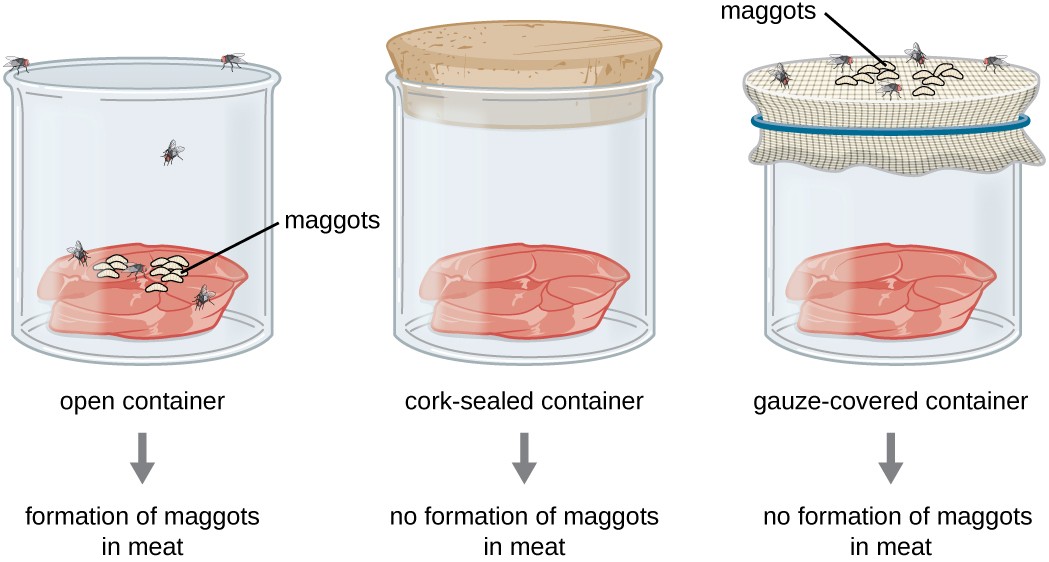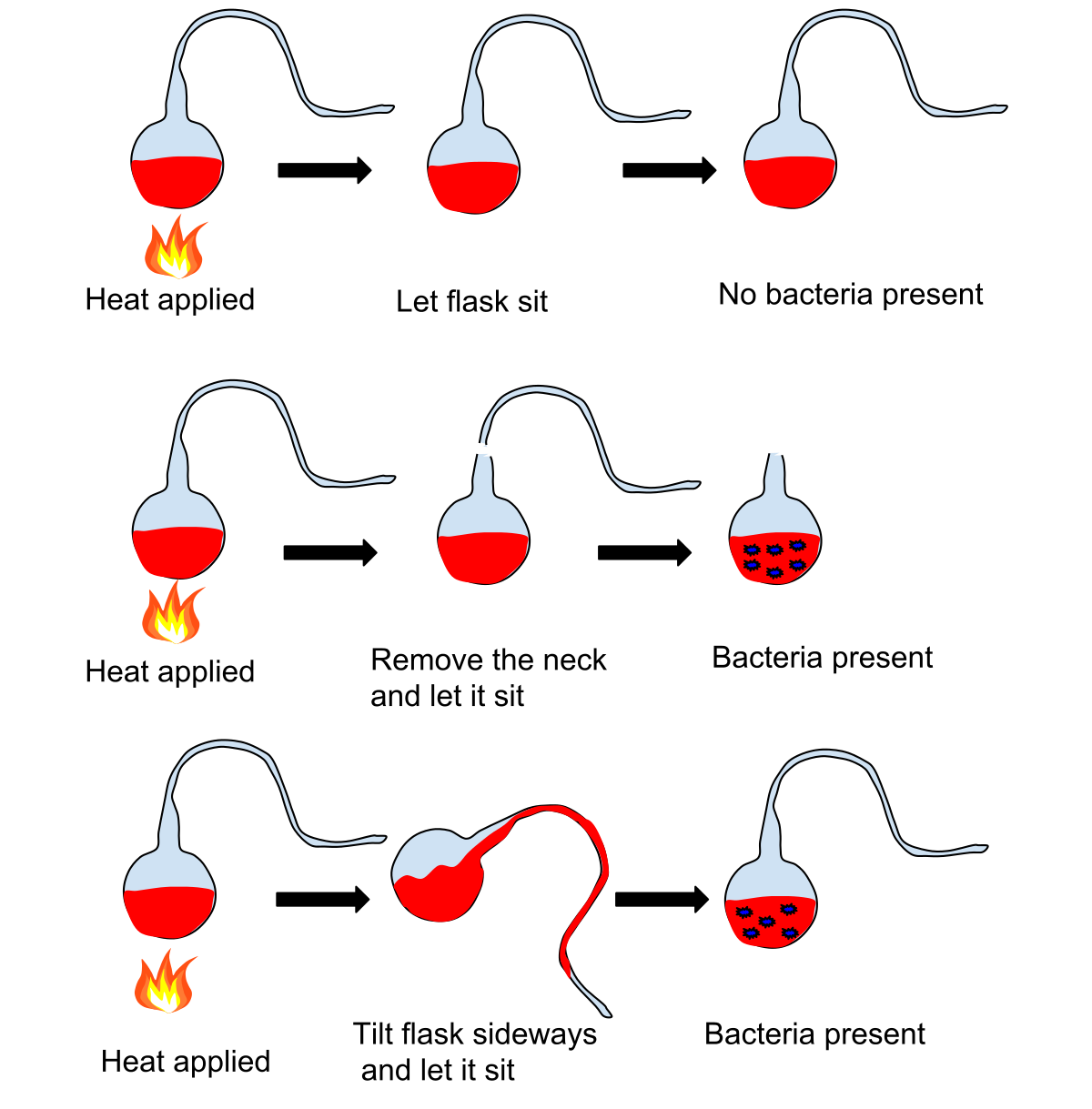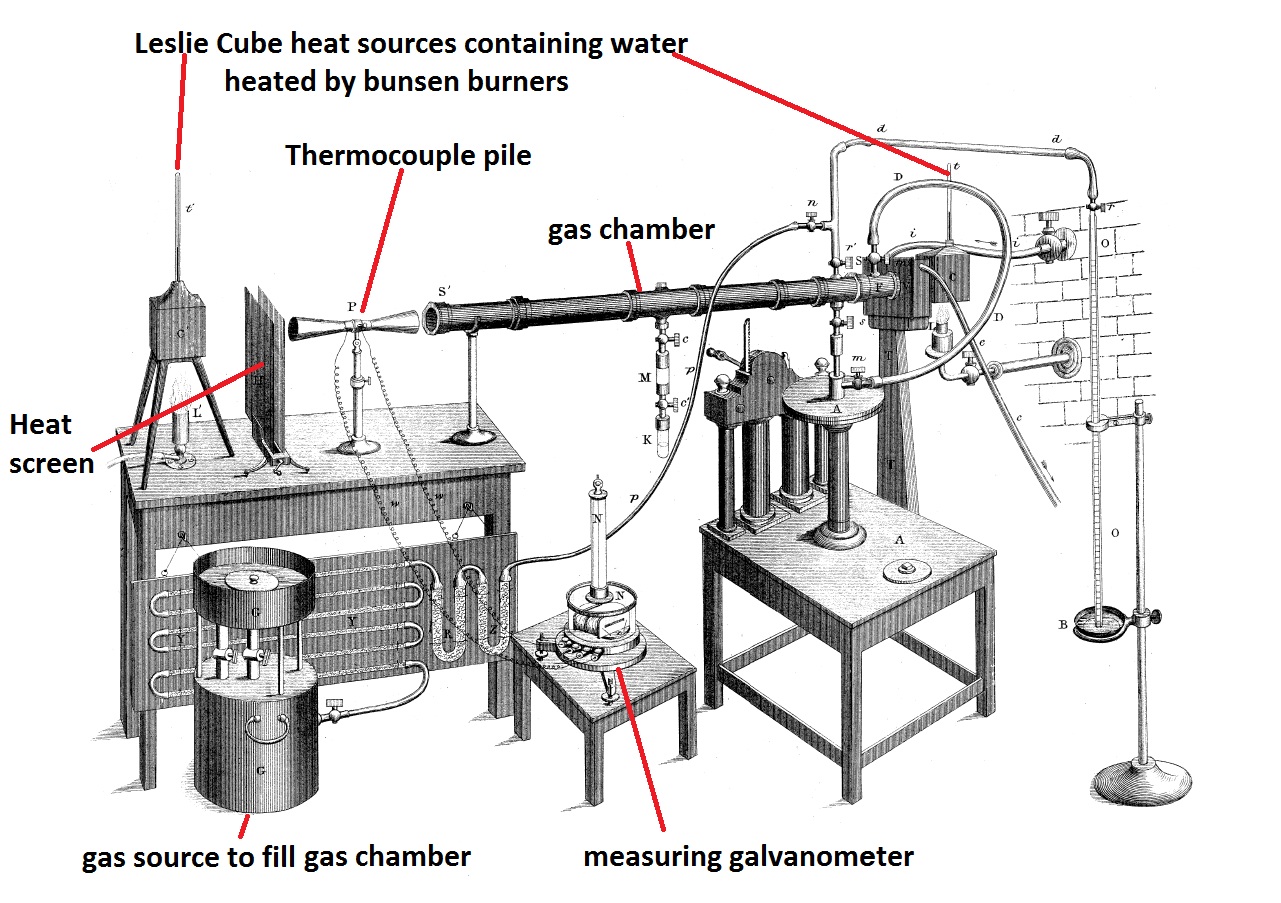A-biogenesis or Spontaneous Generation – The generation of life from non-living material is called abiogenesis.
Biogenesis – is the production of new living organisms or organelles from preexisting living things, by reproduction. The term biogenesis was coined by Henry Charlton Bastian.
Aristotle (346 B.C.) believed that life could appear spontaneously from non-living or decomposing matter i.e. snakes and frogs develop from the mud of river banks and maggots and flies appear in decaying food, and maggots and tapeworms arising from cow-dung.
Following experiments were conducted to disprove the spontaneous generation.
1) Francesco Redi’s fly experiment (1665) – Francesco Redi was one of the first to refuse the concept of spontaneous generation. He showed that maggots did not emerge spontaneously from putrefied (decayed) meat but developed from the eggs laid by flies. Redi put meat in three separate Jars.
One of these was closed with a paper cover, this flask showed no evidence of any flies or maggots.
- Another jar was left uncovered in this jar flies laid their eggs on the meat and within a short period of time maggots and newly emerging adult flies appeared.
- The third jar was covered with fine gauze. Naturally, the meat readily putrefied and attracted flies they laid their eggs on the gauze. And new flies appeared on the gauze.
 |
| Francesco Redi’s fly experiment |
Conclusion – Maggots and the flies, into which they develop, come not from the meat itself but the eggs left on the meat by other flies. Thus Redi proved that flies were not spontaneously generated from meat but were developing from the eggs laid by other flies.
2) Louis Joblot (1711) found the same evidence when be observed that infusions stoppered tightly immediately after boiling remained free of microorganisms. However, if these stoppered preparations were later opened and exposed to the air, animalcules soon appeared.
3) John Needham (1749) Necdham’s studies consisted of tightly corking flasks of boiled meat broth and observing them periodically for cloudiness t.e. microbial growth. Some containers showed no growth but most containers showed microbial growth.
Conclusion – Since boiling was known to destroy microorganisms as well as any other living cells, Needham concluded that the organi¢ matter in his flasks possessed a “Vital or vegetative force” that could confer the properties of life on the nonliving elements present.
4) Abbe Lazzaro Spallanzani (1768). Spallanzani found that sealed flasks containing infusions heated for one hour showed no cloudiness after a reasonable period. Spallanzani responded by breaking the seal on his heated, closed flasks, allowing exposure to air. Within a short period, the contents of these flasks became turbid, showing that the long-heated organic matter was still capable of supporting life.
5) Theodor Schwann (1836) set up two separate flasks containing infusion. In one flask air was passed through a red-hot tube before entering the flask containing the nutrient material. This flask remained free of any growth as heating destroyed all life forms. In another flask that received unheated air, soon growth developed.
6) Franz Schulze (1836) in his experiments in one jar he passed the air to pass through strong acids like sulfuric acid and sodium hydroxide before entering into nutrient/meat. No growth developed in this flask while in another that received untreated air, soon growth developed.
Conclusion – Above experiments concluded that the treatments of the air with heat or chemicals destroyed all possible “‘life-generating power”.
7) Henrich George Friedrich Schroder and Theodor Von Dusch (1854) introduced the use of cotton plugs for bacteriological culture flasks and tubes. Using Schulze and Schwann’s system, these scientists allowed air to enter untreated in any way except by being filtered through cotton wool that had been previously heated in an oven. Flasks that received filtered air showed no growth, while flasks flask without cotton plugs receiving unfiltered air contained microorganisms.
8) Pasteur’s experiment – Pasteur passed large volumes of air through a tube with a plug of gun cotton as a filter. A piece of the gun cotton was then dissolved in alcohol – ether mixture and the remaining sediment was examined under the microscope. Pasteur found small round and oval bodies that resembled the spores (reproductive structures) of plants. To show that the gun-cotton not only stopped the passage of microorganisms but contained these forms of life as well, Pasteur simply added a little of the used filter to sterile meat infusions. Soon microbial growth appeared. Thus Pasteur confirmed how microbes gained access to nutrients and how they could be prevented from doing so.
Nutrient liquid media were placed in the flasks and both the container and liquid contents were sterilized by boiling. No plugs of any type were used to prevent the passage of microorganisms into these systems. Microorganisms present in the air could not reach the main part of the flask due to the large length and the end of the flask’s swan neck. When the top of a system was broken off or if a flask were tilted so that the sterile liquid nutrient ran into the exposed part of the neck and then returned, microbes soon appeared in the fluids.
 |
| Pasteur’s experiment |
9) John Tyndall (1877) – gave the final blow to spontaneous generation. In his work on the optical properties of atmospheric dust, he observed that a beam of light passing through the air without any dust particles was invisible. On the other hand, a beam of light passing through a dust-containing environment was clearly visible. He built a chamber equipped with side windows and curved tubular vents through which bacteria could not enter. The inside surfaces of this box were coated with glycerol to trap the dust particles that sooner or later would come to settle on the surfaces. This chamber was fitted with a rack of test tubes. When the chamber was found to be optically empty of floating matter, simply by shining a beam of light through its windows, the test tubes were filled with a broth, which was then sterilized by immersing the tubes in boiling brine. Tyndall found that the broth remained sterile even though it was in direct contact with the air of the chamber. When dust-containing air was introduced microbial growth appeared after a brief time. Tyndall demonstrated that bacterial life occurred in sterile broth only after it was introduced from an outside source.
 |
| John Tyndall experiment |
Conclusion- Tyndall concluded that bacteria existed in two forms.
a) Thermo-labile form – are those which are was killed easily by a few minutes of exposure to boiling temperatures and
b) Thermo-stable form was resistant to boiling for several hours. These bacteria were found to contain heat-resistant structures named spores by Ferdinand Cohn (1877).